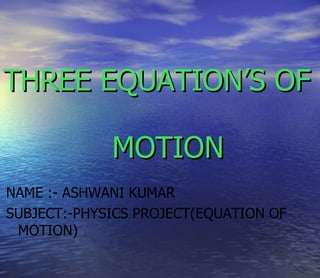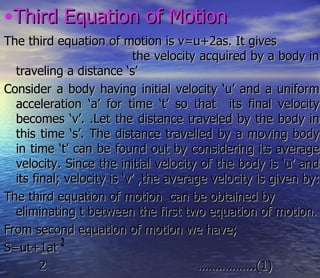3 equation of motion
- 1. THREE EQUATIONâS OF MOTION NAME :- ASHWANI KUMAR SUBJECT:-PHYSICS PROJECT(EQUATION OF MOTION)
- 2. âĒFirst Equation of Motion The first equation of motion is v=u + at. It gives the velocity acquired by a body in time t. Consider a body having initial velocity âuâ. Suppose it is subjected to a uniform acceleration âaâ so that after time âtâ its final velocity becomes âvâ. Now, from the definition of acceleration we know that; â> Acceleration=Change in velocity Time taken â> Acceleration=Final velocity âInitial velocity Time taken â> a=v - u t â> at=v - u â> v=u + at
- 3. âĒSecond Equation of Motion The second equation of motion is s=ut + 1at. It gives 2 the distance traveled by a body in time t. Consider a body having initial velocity âuâ and a uniform acceleration âaâ for time âtâ so that its final velocity becomes âvâ. .Let the distance traveled by the body in this time âsâ. The distance travelled by a moving body in time âtâ can be found out by considering its average velocity. Since the initial velocity of the body is âuâ and its final; velocity is âvâ ,the average velocity is given by: â> Average velocity=Initial velocity+ final velocity 2 â> Average velocity=u + v 2
- 4. Distance travelled= average velocity x Time â> S=(u + v) x t âĶâĶâĶâĶâĶâĶâĶâĶ.(1) 2 From the first equation of motion we have ,v=u + at. Putting the value of v in equation (1), we get â> S=(u+ u+ at) x t 2 â> S=(2u+at) x t 2 â> S=2ut+ at2 2 â> S= ut+1at2 2
- 5. âĒThird Equation of Motion The third equation of motion is v=u+2as. It gives the velocity acquired by a body in traveling a distance âsâ Consider a body having initial velocity âuâ and a uniform acceleration âaâ for time âtâ so that its final velocity becomes âvâ. .Let the distance traveled by the body in this time âsâ. The distance travelled by a moving body in time âtâ can be found out by considering its average velocity. Since the initial velocity of the body is âuâ and its final; velocity is âvâ ,the average velocity is given by: The third equation of motion can be obtained by eliminating t between the first two equation of motion. From second equation of motion we have; S=ut+1at 2 âĶâĶâĶâĶâĶ..(1)
- 6. And from the first equation of motion we have; â> v=u + at This can be rearranged and written as â> at=v - u â> t=v - u a Putting the value of tin equation (1)we get; â> S=u (v-a)+1a(v-u/a) 2 â> S=uv-u+a(v+u-2uv) a 2a â> S=2uv-2u+v+u-2uv 2a â> 2as= v â u â> V=u+2as
- 7. THE END






